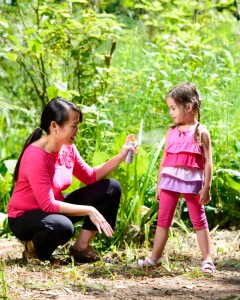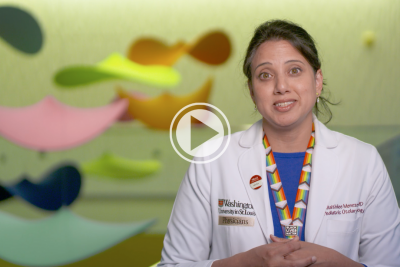 It’s hard to feel good about putting synthetic bug repellents on your kids. They smell like chemicals and the bottles are covered in warnings. Is there a more natural bug repellent that actually works?
It’s hard to feel good about putting synthetic bug repellents on your kids. They smell like chemicals and the bottles are covered in warnings. Is there a more natural bug repellent that actually works?
The short answer is yes. The bad news is that studies show that nothing compares to the efficacy and duration of the combination of DEET and permethrin. The good news is that DEET and permethrin aren’t really as scary as they seem. I outline the real risks of DEET and permethrin below, but first, let’s talk about the most effective natural bug repellents.
Skipping bug repellent all together really isn’t a good option. Mosquito and tick bites are more than just an itchy annoyance– untreated they often result in drug-resistant skin infections from the bacteria MRSA. Ticks can carry diseases such as Lyme Disease and Babesiosis. In the United States, mosquitos can transmit West Nile Virus, Eastern Equine Encephalitis, and many others (the CDC has a complete list of mosquito borne illneses here).
There are many effective plant-derived mosquito repellants, including:
- Picaridin: Found in Cutter and Sawyer products, picaridin is a plant-derived compound that is effective against mosquitoes and ticks. The strongest available picaridin product is the 20% solution sold as Sawyer Family Controlled-Release Insect Repellent. Picaridin is a descent mosquito repellant but not-so-great for ticks. In field studies, 20% picaridin is comparable to DEET as a mosquito repellent for up to five hours. It’s efficacy against ticks only lasted about an hour.
- PMD: The active ingredient in oil of lemon eucalyptus, PMD is a plant-derived ingredient that has been listed by the Environmental Protection Agency (EPA) as effective against mosquitoes and other insects. PMD is found in three major insect repellent brands: Repel, Survivor, and Off. PMD is approximately one-half as effective as DEET for mosquitos, so that a 30 percent PMD product would protect as well as a 15 percent DEET product. One study that compared 40% PMD to 25% DEET reported a mean protection time of 3.8 hours with PMD compared with 5.6 hours with DEET.
- Essential oils: There are many essential oils that have some efficacy as insect repellents, and there is research to support this. PMD, above, is derived from lemon eucalyptus oil. Curcuma longa, Pogostemon heyneanus and Zanthoxylum limonella have also been shown to be effective repellents in recent studies. Sadly, only PMD approaches the efficacy of DEET. For more on essential oils and why they have become a permanent part of western medicine, read my article here.
What are the real risks of DEET and permethrin, especially in children and pregnant women?
- DEET: DEET is actually a very safe agent when used on the skin. But even if your kids lick their fingers after applying DEET repellant, they will probably be fine. Very, very rarely there have been times where kids have had toxic reactions to using DEET on their skin. According to the CDC, DEET has been marketed in the United States since 1956 and is used by an estimated 50-100 million persons each year. Since 1961, only six cases of toxic systemic reactions from repeated cutaneous exposure to DEET have been reported. In each of these cases the children were using repeated, high doses of DEET to the skin. Another six cases of toxicity have been reported after ingestion of DEET products.
DEET just seems scarier than it actually is.
3M Ultrathon is a DEET-containing repellent that is microencapsulated. Microencapsulation means the DEET won’t be absorbed by your skin as fast and the insect protection will last longer.
Pick a product with 10-35% DEET. The effectiveness of DEET plateaus at about 30%, but products with more than 30% will last longer. Products with concentrations around 10% are effective for about 2 hours, compared to 25% DEET products that last about 5 hours in some studies.
If you have a newborn, it’s best to use mosquito nets and clothing to keep the bugs away from your baby. Get a mosquito net that fits over your baby-carrier, car seat, stroller, or pack-and-play (you can buy them at major retailers and online). There are very few studies that look at the effects of DEET on infants under two months of age, and rare side effects have been reported, so the American Academy of Pediatrics recommends that DEET products should not be used in this age group.
If you are pregnant or breastfeeding, you can still use DEET. The CDC recommends that pregnant women use DEET based repellents to avoid arboviral infections such as West Nile Virus.
- Permethrin: Permethrin is not actually a repellent, it doesn’t keep the bugs away from you, it just kills them on contact. Permethrin is a bug neurotoxin, which makes it rather unnerving to put on your kids. Fortunately, its toxicity in humans is very low. I prescribe permethrin for use on skin to treat scabies and head lice. When applied to clothing rather than skin its toxicity is negligible. I have personally used premethrin treated clothing while pregnant. Premethrin is great for clothing, mosquito nets, and screens. Permethrin is excellent protection for both mosquitos and ticks, as well as other insects. The bugs usually die on contact with the treated material. You can usually wash treated clothing several times without losing efficacy. I have a skirt I treat years ago with permethrin and the bugs still don’t bite me when I wear it. You can buy clothing that is already impregnated with permethrin, or you can just buy a bottle of permethrin and treat your own clothes.
The combination of Permethrin treated clothing and DEET-containing repellent on exposed skin is the best known protection for both mosquitoes and ticks, especially the Ixodes tick, which carries Lyme Disease. This is the approach I choose for my family. I’ve tried other products, but nothing is as effective, long lasting, and convenient as this combination. We also use a lot of mosquito nets on baby equipment, screen tents, and screen porches.
After the bite– how to make the itch go away: I treat mosquito bites aggressively and quickly, before they get scratched with dirty little toddler fingers. It’s best to treat bites as soon as you realize you’ve been bitten, hopefully even before the bite begins to swell. If you treat the bite early enough it may only last hours, not days. You’ll thank yourself at the end of the day when you’re kids aren’t itchy and grumpy. Early treatment also prevents the skin infections that come with scratching.
My magic combo for mosquito bites is topical hydrocortisone ointment or cream and an oral (by mouth) antihistamine such as benadryl, Zyrtec, Allegra, or Claritin. These drugs are available over-the-counter (here are my 12 tips for saving money on over-the-counter medications).
Tick bites can also be itchy, and can be treated the same way. If you notice a round rash developing around the site of the tick bite, this can be a sign of Lyme disease or other tick-borne illnesses, and you should seek medical attention.
Are you headed out for a family camping or road trip? Don’t leave home without your family first aid kit– here’s a list of everything you need to avoid spending your vacation in the ER. Then save yourself some grief and read my 10 Tricks for a Family Road Trip and avoid a National Lampoon’s family vacation.





Comments